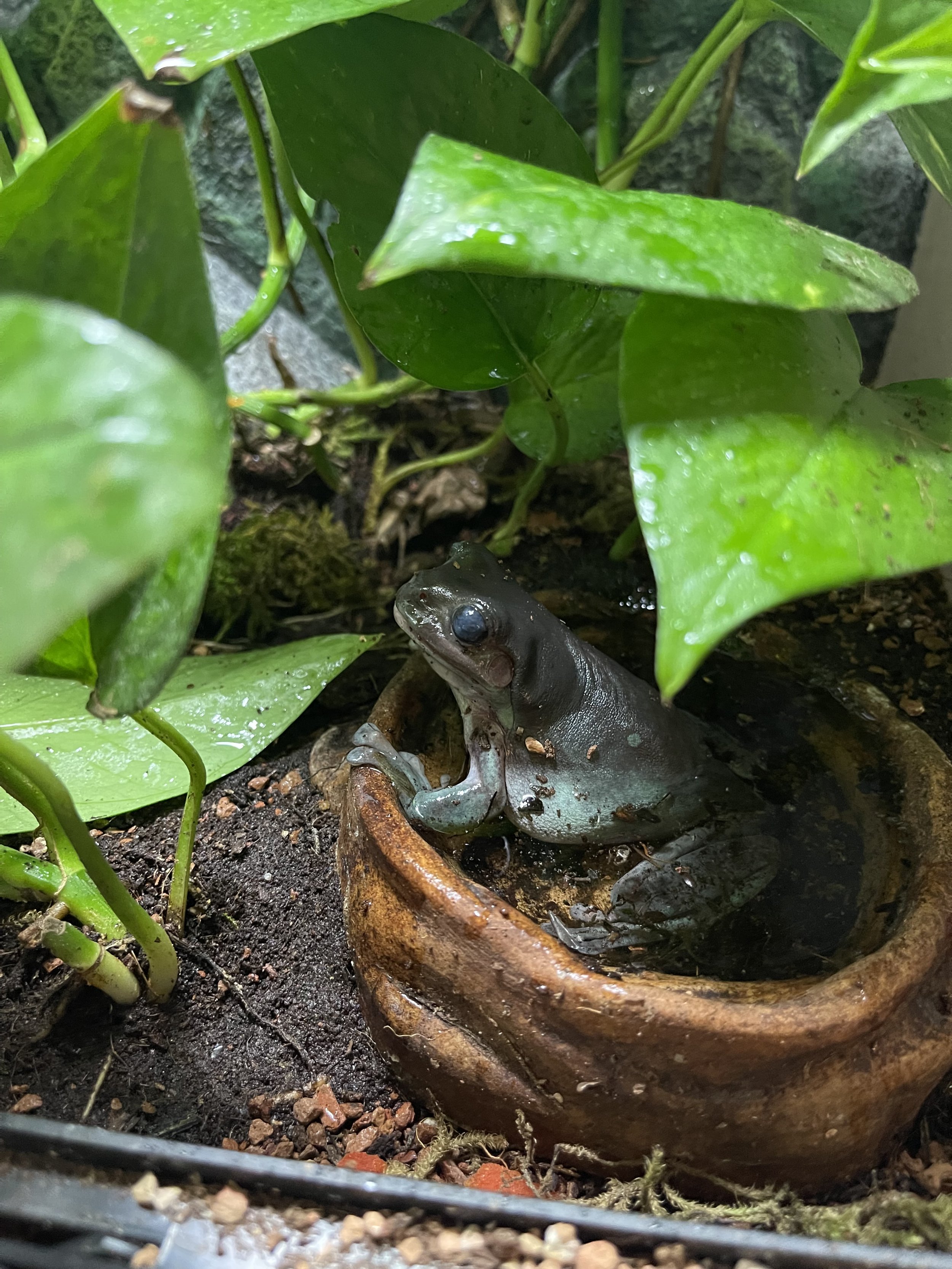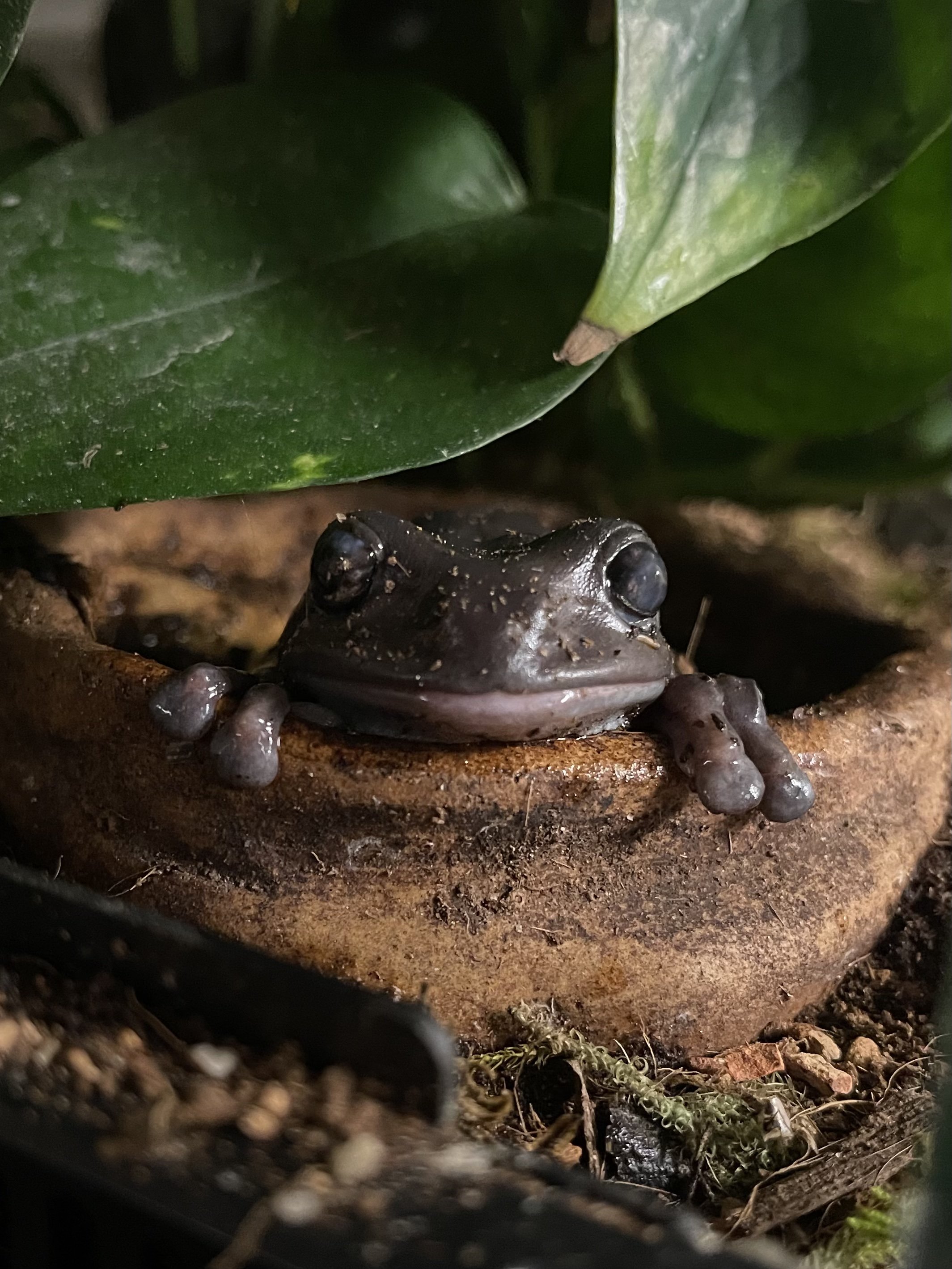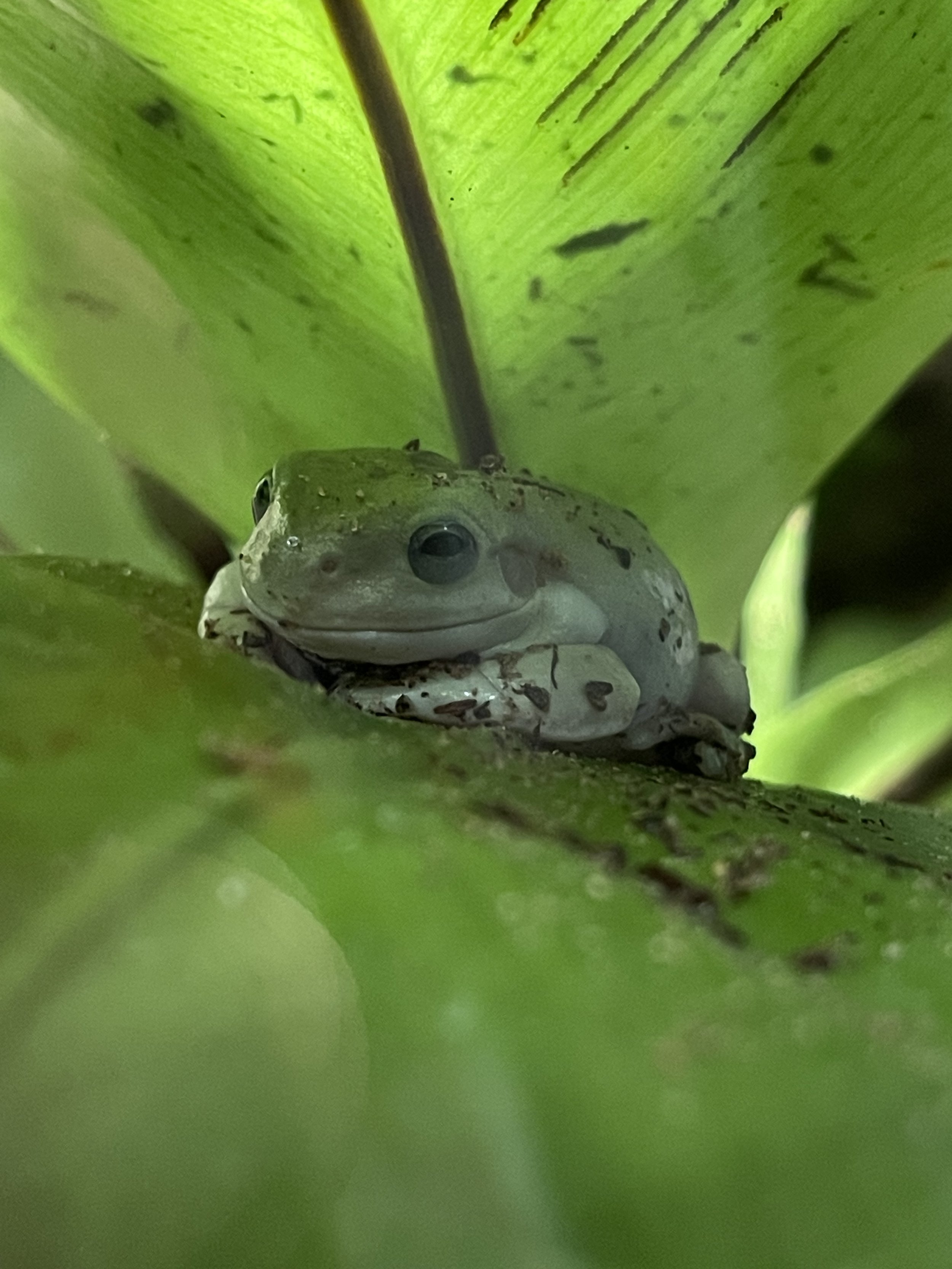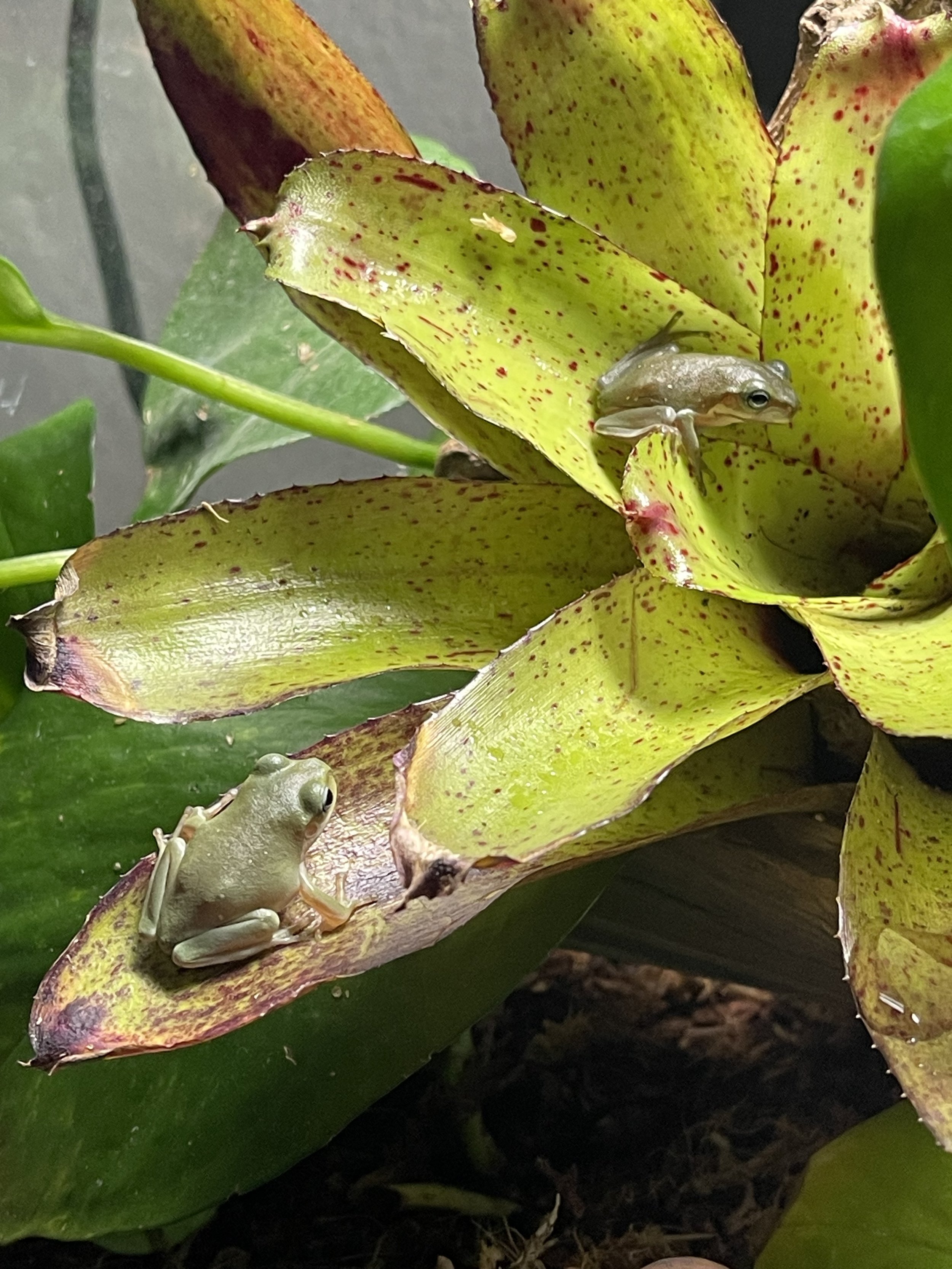The Ultimate Care Guide for White's Tree Frogs
White's Tree Frogs hold a special place in our hearts since adopting Max in 2021. In the short time he was with us, he enriched our lives and taught us so much about animal husbandry.
You can read about Max here.
White’s Tree Frogs (also known as Dumpy Frogs for their chubby appearance) are among the most popular amphibians in the pet trade. Native to Australia and New Guinea, these frogs are incredibly captivating. Here's a comprehensive care guide to help you provide the best environment for your White's Tree Frogs.
Habitat Setup
Enclosure Size
For one adult White's Tree Frog, a minimum of a 30-gallon (18” L x 18” W x 24” H) vertical tank is recommended. If housing multiple frogs, increase the size accordingly. A good rule of thumb is to increase the tank size by at least 10 gallons for every frog you add as they will use all of the space you give them. They are arboreal and love to explore, so a tank taller than it is wide is needed to provide ample climbing space. Glass tanks with screen or mesh tops are best and should have adequate ventilation. Our 3 dumpy frogs are in a 120-gallon glass enclosure, providing them with more than enough space to adventure around the tank.
These frogs can have a voracious appetite so they can and will eat another frog if there is too great of a size difference between them. Only house same-sized frogs together; avoid keeping babies with adults. The smallest frog should be at least half the size of the largest frog, if not closer in size if possible.
Substrate
Being native to Australia and southern New Guinea, White’s tree frogs prefer moist, forested environments but have skin that can adjust to drier situations (hence making them a great beginner’s frog). Use a moisture-retaining substrate such as coconut fiber, organic topsoil, or a mix with play sand. Avoid substrates that can cause impaction if ingested like wood chips or sphagnum moss, especially when housing baby frogs. If they think something could be a bug (like a small piece of bark), they will strike!
Temperature
Maintain a temperature gradient of 75-85°F during the day, with a slight drop to 70-75°F at night. Use a reliable thermometer to monitor temperatures. Heat mats are not good as they don’t raise the air temperature enough, spike the humidity, and can cause burns on the frogs. Whichever route you choose to heat the enclosure, always plug your heat source into an adjustable thermostat to prevent heat spikes. A thermostat will shut off an overheating bulb, preventing an emergent and potentially deadly situation.
The best option for heating your Whites tree frog enclosure depends in part on the ambient temperature in your home. We use an incandescent bulb to maintain a temperature gradient during the day with a basking spot of 88 degrees Farenheit, and at night our ambient temperature does not drop below 70 degrees Fahrenheit. We provide plenty of perches at various heights to allow our frogs to self-regulate their body temperatures. If you like to keep your home on the cooler side, you may want to use a ceramic heat projector as this will not emit light. A ceramic heat projector can maintain a safe temperature day and night in this situation, but allowing a slight drop in temperature at night mimics a frog’s natural environment.
Humidity
Keep in mind that these are not tropical frogs, so when it comes to humidity, think forest frogs. Ideal humidity is in the 50-70% range depending on when you last misted their tank. Anything higher than 70% humidity for prolonged periods can cause respiratory, bacterial, and fungal infections, especially if the temperatures are too cool. Aim for a consistent humidity level with a spike once a day. Use a good-quality hygrometer to monitor humidity levels.
Lighting
While not strictly necessary, providing a low-level UVB light for 10-12 hours a day can benefit the frogs' overall health. The Arcadia Shade Dweller D3 7% UVB T5 Bulb is the best choice to provide UVB lighting to your frog. If not using a UVB bulb, Vitamin D3 should be supplemented in the frog’s diet. When provided UVB lighting, frogs will produce as much Vitamin D as their bodies need on their own. Without it, they rely on us to supplement their food - we must be careful with this to prevent overdosing the animal on Vitamin D, or causing Metabolic Bone Disease from lack of supplementation or UVB.
Decor
Provide plenty of climbing branches, foliage (real or artificial), and hiding spots to mimic their natural environment and promote natural behaviors.
Try to provide live plants, as mimicking a frog’s natural habitat is best practice. There are tons of fun hides in different themes sold online, made by small businesses!
Diet and Nutrition
Diet
White's Tree Frogs are insectivores. A varied diet of gut-loaded crickets, dubia roaches, earthworms, silkworms, and occasionally, superworms or waxworms as treats, is ideal. To gut load your crickets, feed them reptile-safe veggies at least 24 hours before feeding them to your reptiles. To make it easy to do this, we have storage totes from Walmart that we drilled holes in for ventilation. We simply provide food and egg carton hides for the insects, and pull from that source at feeding times. Dubia Roaches is a great feeder option that ships from the central US.
Feeding Schedule
Juvenile frogs should be fed daily, but adults should be fed every 2-3 days. Leaving excess uneaten insects can pose a risk to your frog, as some (like crickets) will bite and cause injury to your frog.
Adjust the quantity and insect size based on the frog's size. The insect should not be longer than the space between your frogs’ eyes are wide.
Supplements
Dust food items with a calcium supplement twice a week and a multivitamin once a week to prevent nutritional deficiencies. If using a UVB bulb in your frog’s enclosure, ensure that your calcium does not contain Vitamin D3.
Water and Hydration
Water Bowl
Always provide a bowl of clean, dechlorinated water large enough for the frog to soak in. Do not use untreated tap water with frogs and other amphibians, due to the presence of chlorine used in the water purification process.
If a chlorinated source of water must be used, treat it first with a de-chlorinator or allow the water to sit out for at least 24 hours. Avoid providing too deep of a water bowl, as these frogs are NOT good swimmers and could drown if they can’t touch the bottom of the bowl.
Misting
Regular misting of the enclosure helps maintain humidity and provides a water source, as White's Tree Frogs can drink water droplets off leaves. Avoid misting too frequently or drenching the enclosure, as this can do more harm than good in risking a fungal or bacterial infection for your frog.
Health & Wellness
Signs of Good Health
A healthy White's Tree Frog should have smooth skin, clear eyes, a robust body, and be actively hunting during feeding times. If you’re ever concerned for your frog’s health, find an exotic vet near you! Treatment can be fairly inexpensive for frogs compared to other pets.
Common Health Issues
Watch out for signs of illness such as lethargy, weight loss, swollen joints, cloudy eyes, or skin abnormalities. Metabolic bone disease (due to calcium deficiency) and chytrid fungus are notable concerns.
Veterinary Care
Schedule regular check-ups with a veterinarian experienced in amphibian care to ensure your frog's health and address any concerns early.
Handling and Interaction
Handling
White's Tree Frogs can tolerate gentle handling, but always wash your hands thoroughly before and after to prevent the transfer of harmful oils and salts. Frogs absorb through their skin, so wearing latex-free gloves is a great extra step at mitigating as much risk as possible.
Social Needs
These frogs are generally extremely sociable with their kind but monitor interactions to prevent bullying, especially during feeding times. They can be shy of people when they’re young and are most active at night, so installing a nanny cam is a fun way to observe their natural behaviors.
Conclusion
Caring for White's Tree Frogs offers a rewarding experience, and is quite simple with the right care knowledge. By providing a well-maintained habitat, a balanced diet, and regular health checks, you can ensure your Whites Tree Frogs lead happy and healthy lives.
The key to successful frog care is creating an environment that closely mimics their natural habitat, coupled with patience and attention to their unique needs.






